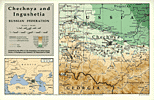
cartome.org
18 August 2001

Geography and Map Division,
Library of Congress
Online Map Collections
"The mission of the Library of Congress is to make its resources available and useful to Congress and the American people and to sustain and preserve a universal collection of knowledge and creativity for future generations. The goal of the Library's National Digital Library Program is to offer broad public access to a wide range of historical and cultural documents as a contribution to education and lifelong learning.
The Library of Congress presents these documents as part of the record of the past. These primary historical documents reflect the attitudes, perspectives, and beliefs of different times. The Library of Congress does not endorse the views expressed in these collections, which may contain materials offensive to some readers."
| Cities/Towns | Conservation/Environment | Discovery/Exploration | General Maps | Cultural Landscapes | Military Battles/Campaigns | Transportation/Communication
Cities and Towns: The Cities and Towns category includes maps that depict individual buildings to panoramic views of large urban areas. These maps record the evolution of cities illustrating the development and nature of economic activities, educational and religious facilities, parks, street patterns and widths, and transportation systems.
Conservation and Environment: The historic and more recent maps contained in this category show early exploration and subsequent land use in various areas of the United States. These maps show the changes in the landscape, including natural and man-made features, recreational and wilderness areas, geology, topography, wetland area, vegetation, and wildlife. Specific conservation projects such as the growth and development of U.S. National Parks are included in this category.
Discovery and Exploration: This category documents the discovery and exploration with both manuscripts and published maps. Many of these maps reflect the European Age of Discoveries, dating from the late 15th century to the 17th century when Europeans were concerned primarily with determining the outline of the continents as they explored and mapped the coastal areas and the major waterways. Also included are 18th and 19th century maps documenting the exploration and mapping of the interior parts of the continents, reflecting the work of Lewis and Clark and subsequent government explorers and surveyors.
General Maps: This category includes maps that typically portray the physical environment and a variety of cultural elements for a geographic area at a particular point in time. The maps in this category show a geographic area larger than a city or town and do not display a subject that is part of one of the thematic categories.
Cultural Landscapes: Cultural Landscapes geography is documented in this category by large-scale maps such as individual land surveys, county land ownership maps and atlases, large-scale topographic maps, and thematic maps showing economic activity. These maps show the cultural modification of a physical landscape as settlers established their farmsteads and villages, constructed the connecting transportation systems, and named their surroundings. Some maps show areas occupied by Native Americans, especially after their resettlement by the United States government.
Military Battles and Campaigns: This category contains maps showing campaigns of major military conflicts including troop movements, defensive structures and groundworks, roads to and from sites of military engagements, campsites, and local buildings, topography and vegetation. Some of the maps are manuscripts drawn on the field of battle, while others are engraved including some that have manuscript annotations reflecting the history of the battle or campaign. A significant number of battle maps provide information about the locality that is not available elsewhere such as the location of plantations, the names of landowners in the area, the configuration of small towns and villages, and indications of prior settlement by native Americans.
Transportation and Communication: These maps document the development and status of transportation and communication systems on the national, state, and local level. Transportation maps can depict canal and river systems, cycling routes, railway lines and systems, roads and road networks, and traffic patterns. Communication maps illustrate the location and distribution of telegraph routes, telephone systems and radio coverage.